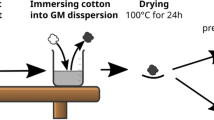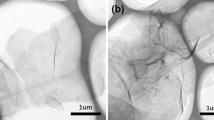Abstract
The present work describes the fabrication of superhydrophobic and superoleophilic reduced graphene oxide-coated cotton (rGO@cotton) by a facile one-step hydrothermal used method for oil-water separation. Results from X-ray diffraction (XRD), Fourier transform infrared spectroscopy (FTIR), and field emission scanning electron microscopy (FESEM) analysis show the formation of a composite structure with the presence of an ultrathin coating of rGO on the cotton fibers. The contact angle (CA) between a static water droplet and the rGO@cotton surface in air was measured ~ 162.9°, which suggests the formation of a superhydrophobic surface on the synthesized product. Moreover, the rGO@cotton showed excellent absorption capacity for oils where 1 g of rGO@cotton was able to remove ~ 30–40 g of various oils in the first cycle from oil-water mixtures. The flexible rGO@cotton was reusable and demonstrated oil retention up to ~ 35–50% at the tenth cycle using simple sorption-mechanical squeezing test. Overall, the present work identifies that the rGO@cotton is an efficient absorbent for effective separation of oil from oil-water mixtures.

Oil-water separation by reduced graphene oxide modified cotton.









Similar content being viewed by others
References
Chu Z, Feng Y, Seeger S (2015) Oil/Water Separation with Selective Superantiwetting/Superwetting Surface Materials. Angew Chem Int Ed 54:2328. https://doi.org/10.1002/anie.201405785
Ma Q, Cheng H, Fane AG, Wang R, Zhang H (2016) Recent Development of Advanced Materials with Special Wettability for Selective Oil/Water Separation. Small 12:2186. https://doi.org/10.1002/smll.201503685
Chen P-C, Xu Z-K (2013) Mineral-Coated Polymer Membranes with Superhydrophilicity and Underwater Superoleophobicity for Effective Oil/Water Separation. Sci Rep 3:2776. https://doi.org/10.1038/srep02776
Gupta RK, Dunderdale GJ, England MW, Hozumi A (2017) Oil/water separation techniques: a review of recent progresses and future directions. J Mater Chem A 5:16025-58. https://doi.org/10.1039/C7TA02070H
Kota AK, Kwon G, Choi W, Mabry JM, Tuteja A (2012) Hygro-responsive membranes for effective oil-water separation. 3:1025. https://doi.org/10.1038/ncomms2027
Liu F, Ma M, Zang D, Gao Z, Wang C (2014) Fabrication of superhydrophobic/superoleophilic cotton for application in the field of water/oil separation. Carbohydr Polym 103:480. https://doi.org/10.1016/j.carbpol.2013.12.022
Li R, Chen C, Li J, Xu L, Xiao G, Yan D (2014) A facile approach to superhydrophobic and superoleophilic graphene/polymer aerogels. J Mater Chem A 2:3057. https://doi.org/10.1039/C3TA14262K
Zhu Q, Pan Q, Liu F (2011) Facile Removal and Collection of Oils from Water Surfaces through Superhydrophobic and Superoleophilic Sponges. J Phys Chem C 115:17464. https://doi.org/10.1021/jp2043027
Gupta S, Tai N-H (2016) Carbon materials as oil sorbents: a review on the synthesis and performance. J Mater Chem A 4:1550. https://doi.org/10.1039/C5TA08321D
Inagaki M, Konno H, Toyoda M, Moriya K, Kihara T (2000) Sorption and recovery of heavy oils by using exfoliated graphite Part II: Recovery of heavy oil and recycling of exfoliated graphite. Desalination 128:213. https://doi.org/10.1016/S0011-9164(00)00035-7
Li H, Zhao X, Wu P, Zhang S, Geng B (2016) Facile preparation of superhydrophobic and superoleophilic porous polymer membranes for oil/water separation from a polyarylester polydimethylsiloxane block copolymer. J Mater Sci 51:3211. https://doi.org/10.1007/s10853-015-9632-6
Yu Y, Wu X, Fang J (2015) Superhydrophobic and superoleophilic “sponge-like” aerogels for oil/water separation. J Mater Sci 50:5115. https://doi.org/10.1007/s1085
Wang Y, Liu X, Lian M et al (2017) Continuous fabrication of polymer microfiber bundles with interconnected microchannels for oil/water separation. Appl Mater Today 9:77. https://doi.org/10.1016/j.apmt.2017.05.007
Dunderdale GJ, Urata C, Sato T, England MW, Hozumi A (2015) Continuous, high-speed, and efficient oil/water separation using meshes with antagonistic wetting properties. ACS Appl Mater Interfaces 7:18915. https://doi.org/10.1021/acsami.5b06207
Yin K, Chu D, Dong X, Wang C, Duan J-A, He J (2017) Femtosecond laser-induced robust periodic nanoripple structured mesh for highly efficient oil-water separation. Nano 9:14229. https://doi.org/10.1039/C7NR04582D
Bi H, Yin Z, Cao X et al (2013) Carbon fiber aerogel made from raw cotton: a novel, efficient and recyclable sorbent for oils and organic solvents. Adv Mater 25:5916. https://doi.org/10.1002/adma.201302435
Liu Q, Patel AA, Liu L (2014) Superhydrophilic and underwater superoleophobic poly (sulfobetaine methacrylate)-grafted glass fiber filters for oil-water separation. ACS Appl Mater Interfaces 6:8996. https://doi.org/10.1021/am502302g
Gui X, Wei J, Wang K et al (2010) Carbon Nanotube Sponges. Adv Mater 22:617. https://doi.org/10.1002/adma.200902986
Sansotera M, Navarrini W, Resnati G et al (2010) Preparation and characterization of superhydrophobic conductive fluorinated carbon blacks. Carbon 48:4382. https://doi.org/10.1016/j.carbon.2010.07.052
Zhao M, Liu P (2009) Adsorption of methylene blue from aqueous solutions by modified expanded graphite powder. Desalination 249:331. https://doi.org/10.1016/j.desal.2009.01.037
Ren H, Shi X, Zhu J, Zhang Y, Bi Y, Zhang L (2016) Facile synthesis of N-doped graphene aerogel and its application for organic solvent adsorption. J Mater Sci 51:6419. https://doi.org/10.1007/s10853-016-9939-y
Araby S, Qiu A, Wang R, Zhao Z, Wang C-H, Ma J (2016) Aerogels based on carbon nanomaterials. J Mater Sci 51:9157. https://doi.org/10.1007/s10853-016-0141-z
Sun H, Zhu Z, Liang W et al (2014) Reduced graphene oxide-coated cotton for selective absorption of organic solvents and oils from water. RSC Adv 4:30587. https://doi.org/10.1039/C4RA03208J
Xiao N, Zhou Y, Ling Z, Qiu J (2013) Synthesis of a carbon nanofiber/carbon foam composite from coal liquefaction residue for the separation of oil and water. Carbon 59:530. https://doi.org/10.1016/j.carbon.2013.03.051
Sun Z, James DK, Tour JM (2011) Graphene chemistry: synthesis and manipulation. J Phys Chem Lett 2:2425. https://doi.org/10.1021/jz201000a
Singh V, Joung D, Zhai L, Das S, Khondaker SI, Seal S (2011) Graphene based materials: past, present and future. Prog Mater Sci 56:1178. https://doi.org/10.1016/j.pmatsci.2011.03.003
Zaaba NI, Foo KL, Hashim U, Tan SJ, Liu W-W, Voon CH (2017) Synthesis of Graphene Oxide using Modified Hummers Method: Solvent Influence. Procedia Eng 184:469. https://doi.org/10.1016/j.proeng.2017.04.118
Hummers WS, Offeman RE (1958) Preparation of Graphitic Oxide. J Am Chem Soc 80:1339. https://doi.org/10.1021/ja01539a017
Tang Z, Zhang Z, Han Z, Shen S, Li J, Yang J (2016) One-step synthesis of hydrophobic-reduced graphene oxide and its oil/water separation performance. J Mater Sci 51:8791. https://doi.org/10.1007/s10853-016-9937-0
Fragouli D, Athanassiou A (2017) Graphene heaters absorb faster. Nature Nano 12:406. https://doi.org/10.1038/nnano.2017.63
Liu N, Zhang M, Zhang W et al (2015) Ultralight free-standing reduced graphene oxide membranes for oil-in-water emulsion separation. J Mater Chem A 3:20113. https://doi.org/10.1039/C5TA06314K
Liu Y, Ma J, Wu T et al (2013) Cost-effective reduced graphene oxide-coated polyurethane sponge as a highly efficient and reusable oil-absorbent. ACS Appl Mater Interfaces 5:10018. https://doi.org/10.1021/am4024252
Ge B, Zhang Z, Zhu X, Men X, Zhou X, Xue Q (2014) A graphene coated cotton for oil/water separation. Compos Sci Technol 102:100. https://doi.org/10.1016/j.compscitech.2014.07.020
Upadhyay RK, Dubey A, Waghmare PR, Priyadarshini R, Roy SS (2016) Multifunctional reduced graphene oxide coated cloths for oil/water separation and antibacterial application. RSC Adv 6:62760. https://doi.org/10.1039/C6RA08079K
Ge J, Shi L-A, Wang Y-C et al (2017) Joule-heated graphene-wrapped sponge enables fast clean-up of viscous crude-oil spill. Nat Nanotechnol 12:434. https://doi.org/10.1038/nnano.2017.33
Periasamy AP, Wu W-P, Ravindranath R, Roy P, Lin G-L, Chang H-T (2017) Polymer/reduced graphene oxide functionalized sponges as superabsorbents for oil removal and recovery. Mar Pollut Bull 114:888. https://doi.org/10.1016/j.marpolbul.2016.11.005
Luo Y, Jiang S, Xiao Q, Chen C, Li B (2017) Highly reusable and superhydrophobic spongy graphene aerogels for efficient oil/water separation. Sci Rep 7:7162. https://doi.org/10.1038/s41598-017-07583-0
Niu Z, Chen J, Hng HH, Ma J, Chen X (2012) A leavening strategy to prepare reduced graphene oxide foams. Adv Mater 24:4144. https://doi.org/10.1002/adma.201200197
Zhang M, Wang C, Wang S, Li J (2013) Fabrication of superhydrophobic cotton textiles for water-oil separation based on drop-coating route. Carbohydr Polym 97:59. https://doi.org/10.1016/j.carbpol.2012.08.118
Zhou X, Zhang Z, Xu X et al (2013) Robust and durable superhydrophobic cotton fabrics for oil/water separation. ACS Appl Mater Interfaces 5:7208. https://doi.org/10.1021/am4015346
Shahriary L, Athawale AA (2014) Graphene oxide synthesized by using modified hummers approach. Int J Renew Energy Environ Eng 2:58. https://doi.org/10.1016/j.proeng.2017.04.118
Nethravathi C, Rajamathi M (2008) Chemically modified graphene sheets produced by the solvothermal reduction of colloidal dispersions of graphite oxide. Carbon 46:1994. https://doi.org/10.1016/j.carbon.2008.08.013
Lamour G, Hamraoui A, Buvailo A et al (2010) Contact angle measurements using a simplified experimental setup. J Chem Educ 87:1403. https://doi.org/10.1021/ed100468u
Abdolhosseinzadeh S, Asgharzadeh H, Seop Kim H (2015) Fast and fully-scalable synthesis of reduced graphene oxide. Sci Rep 5:10160. https://doi.org/10.1038/srep10160
Hoai NT, Sang NN, Hoang TD (2017) Thermal reduction of graphene-oxide-coated cotton for oil and organic solvent removal. Mater Sci Eng B 216:10. https://doi.org/10.1016/j.mseb.2016.06.007
Leng B, Shao Z, de With G, Ming W (2009) Superoleophobic cotton textiles. Langmuir 25:2456. https://doi.org/10.1021/la8031144
Zhu H, Yang S, Chen D, et al (2016) A Robust Absorbent Material Based on Light-Responsive Superhydrophobic Melamine Sponge for Oil Recovery. Adv Mater Interfaces 3:1500683. https://doi.org/10.1002/admi.201500683
Richard-Campisi L, Bourbigot S, Le Bras M, Delobel R (1996) Thermal behaviour of cotton-modacrylic fibre blends: kinetic study using the invariant kinetic parameters method. Thermochim Acta 275:37. https://doi.org/10.1016/0040-6031(95)02729-7
Shalaby A, Nihtianova D, Markov P, Staneva A, Iordanova R, Dimitriev Y (2015) Structural analysis of reduced graphene oxide by transmission electron microscopy. Bulg Chem Commun 47:291
Bong J, Lim T, Seo K et al (2015) Dynamic graphene filters for selective gas-water-oil separation. Sci Rep 5:14321. https://doi.org/10.1038/srep14321
Nakajima A, Hashimoto K, Watanabe T (2001) Recent studies on super-hydrophobic films. Monatshefte für Chemie Chem Month 132:31. https://doi.org/10.1007/s007060170142
Kubiak K, Wilson M, Mathia T, Carval P (2011) Wettability versus roughness of engineering surfaces. Wear 271:523. https://doi.org/10.1016/j.wear.2010.03.029
Nosonovsky M, Bhushan B (2012) Lotus Versus Rose: Biomimetic Surface Effects. Green Tribology: Biomimetics, Energy Conservation and Sustainability. Green Tribology Springer, Berlin, pp 25–40.
Wang S, Zhang Y, Abidi N, Cabrales L (2009) Wettability and surface free energy of graphene films. Langmuir 25:11078. https://doi.org/10.1021/la901402f
Feng C, Yi Z, She F et al (2016) Superhydrophobic and superoleophilic micro-wrinkled reduced graphene oxide as a highly portable and recyclable oil sorbent. ACS Appl Mater Interfaces 8:9977. https://doi.org/10.1021/acsami.6b01648
Meier GH (2014) Thermodynamics of Surfaces and Interfaces: Concepts in Inorganic Materials. Cambridge University Press and the Materials Research Society 251 pages, ISBN 9780521879088. MRS Bulletin;40:371–2. Epub 04/01.
Yaneva Z, Koumanova B (2006) Comparative modelling of mono-and dinitrophenols sorption on yellow bentonite from aqueous solutions. J Colloid Interface Sci 293:303. https://doi.org/10.1016/j.jcis.2005.06.069
Gui X, Li H, Wang K et al (2011) Recyclable carbon nanotube sponges for oil absorption. Acta Mater 59:4798. https://doi.org/10.1016/j.actamat.2011.04.022
Hu H, Zhao Z, Gogotsi Y, Qiu J (2014) Compressible carbon nanotube–graphene hybrid aerogels with superhydrophobicity and superoleophilicity for oil sorption. Environ Sci Technol Lett 1:214. https://doi.org/10.1021/ez500021w
Park JH, Aluru N (2009) Temperature-dependent wettability on a titanium dioxide surface. Molecular. Simulation 35:31. https://doi.org/10.1080/08927020802398884
Li S, Huang J, Ge M et al (2015) Robust Flower-Like TiO2@Cotton Fabrics with Special Wettability for Effective Self-Cleaning and Versatile Oil/Water Separation. Adv Mater Interfaces 2:1500220. https://doi.org/10.1002/admi.201500220
Hu X, Yu Y, Zhou J et al (2015) The improved oil/water separation performance of graphene oxide modified Al2O3 microfiltration membrane. J Membr Sci 476:200. https://doi.org/10.1016/j.memsci.2014.11.043
Cortese B, Caschera D, Federici F, Ingo GM, Gigli G (2014) Superhydrophobic fabrics for oil-water separation through a diamond-like carbon (DLC) coating. J Mater Chem A 2:6781. https://doi.org/10.1039/C4TA00450G
Zang D, Liu F, Zhang M, Niu X, Gao Z, Wang C (2015) Superhydrophobic coating on fiberglass cloth for selective removal of oil from water. Chem Eng J 262:210. https://doi.org/10.1016/j.cej.2014.09.082
Zhu T, Li S, Huang J, Mihailiasa M, Lai Y (2017) Rational design of multi-layered superhydrophobic coating on cotton fabrics for UV shielding, self-cleaning and oil-water separation. Mater Des 134:342. https://doi.org/10.1016/j.matdes.2017.08.071
Acknowledgements
Authors gratefully acknowledge the partial financial support from the Department of Science and Technology, Science and Engineering Research Board (DST-SERB) (grant number ECR/2016/000959).
Author information
Authors and Affiliations
Corresponding author
Ethics declarations
Conflict of interest
The authors declare that they have no conflict of interest.
Additional information
Highlights
• rGO@cotton-based superhydrophobic material is developed by hydrothermal method.
• A composite structure with an ultrathin coating of rGO on cotton fibers is formed.
• The contact angle (CA) measurement between a static water droplet and rGO@cotton surface in air shows CA ~ 162.9○, which suggests the superhydrophobicity of the material.
• The rGO@cotton can remove ~50–60 times various oils of its weight by simple sorption-mechanical squeezing test.
Electronic supplementary material
Rights and permissions
About this article
Cite this article
Dashairya, L., Rout, M. & Saha, P. Reduced graphene oxide-coated cotton as an efficient absorbent in oil-water separation. Adv Compos Hybrid Mater 1, 135–148 (2018). https://doi.org/10.1007/s42114-017-0019-9
Received:
Accepted:
Published:
Issue Date:
DOI: https://doi.org/10.1007/s42114-017-0019-9




